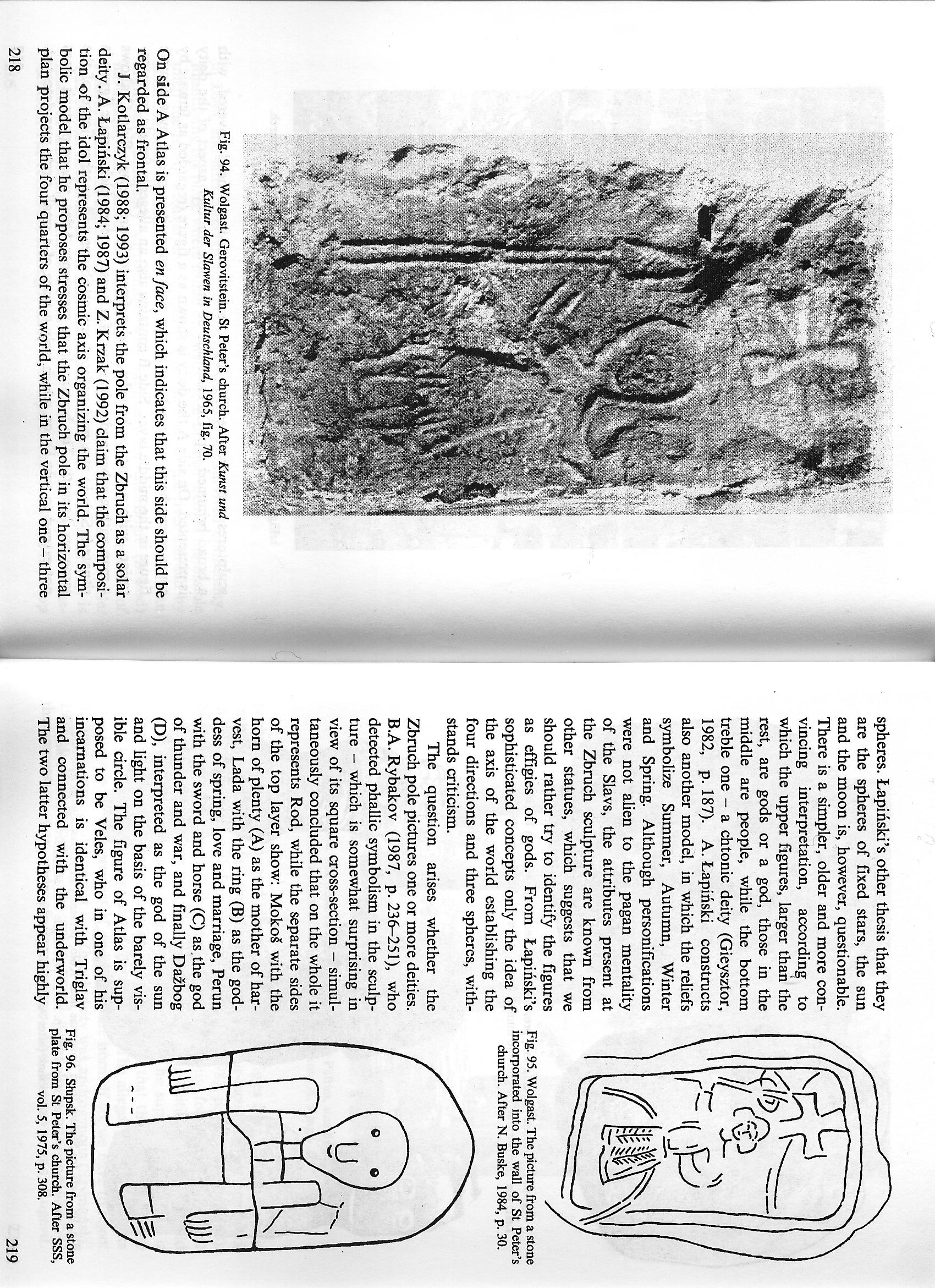89788 image108 (8)


Fig. 94. Wolgast. Gerovitstein. St Peter’s church. After Kunst und Kultur der Slawen in Deutschland, 1965, fig. 70.
On side A Atlas is presented en face, which indicates that this side should be regarded as frontal.
J. Kotlarczyk (1988; 1993) interprets the pole from the Zbruch as a solar deity. A. Łapiński (1984; 1987) and Z. Krzak (1992) claim that the composi-tion of the idol represents the cosmic axis organizing the world. The sym-bolic model that he proposes stresses that the Zbruch pole in its horizontal plan projects the four ąuarters of the world, while in the vertical one - three
spheres. Łapiński’s other thesis that they are the spheres of fixed stars, the sun and the moon is, however, ąuestionable. There is a simpler, older and morę con-vincing interpretation, according to which the upper flgures, larger than the rest, are gods or a god, those in the middle are people, while the bottom treble one - a chtonic deity (Gieysztor, 1982, p. 187). A. Łapiński constructs also another model, in which the reliefs symbolize Summer, Autumn, Winter and Spring. Although personifications were not alien to the pagan mentality of the Slavs, the attributes present at the Zbruch sculpture are known from other statues, which suggests that we should rather try to identify the figures as effigies of gods. From Łapiński’s sophisticated concepts only the idea of the axis of the world establishing the four directions and three spheres, with-stands criticism.

Fig. 95. Wolgast. The picture from a stone incorporated into the wali of St Peter’s church. After N. Buske, 1984, p. 30.

Fig. 96. Słupsk. The picture from a stone piąte from St Peter’s church. After SSS, vol. 5, 1975, p. 308.
The ąuestion arises whether the Zbruch pole pictures one or morę deities. B.A. Rybakov (1987, p. 236-251), who detected phallic symbolism in the sculpture - which is somewhat surprising in view of its square cross-section - simul-taneously concluded that on the whole it represents Rod, while the separate sides of the top layer show: Mokoś with the hora of plenty (A) as the mother of har-vest, Lada with the ring (B) as the god-dess of spring, love and marriage, Perun with the sword and horse (C) as. the god of thunder and war, and finally Dazbog (D), interpreted as the god of the sun and light on the basis of the barely vis-ible circle. The figurę of Atlas is sup-posed to be Veles, who in one of his incamations is identical with Triglav and connected with the underworld. The two latter hypotheses appear highly
219
Wyszukiwarka
Podobne podstrony:
48770 image107 (8) Fig. 92. Altenkirchen. Jaromirstein or “Svantevit”. After Kunst and Kultur der Sl
image045 Fig. 21. Wolgast - a plan from about 1760 (a siraplified copy). The stronghold and St Peter
image108 Fig. 104. Sviatovid frora Zbruch. Aft er A. Gieysztor, 1982, p. 94. from Altfriesack, Fisch
Introduction INTRODUCTION The Basilica of St. Peter is one of the most important eccle-siastical bui
m3375 A French tapestry madę around 1460 illustrates The Life of St Peter. Heavily armoured&nbs
vAct1207Dore St PeterDeliveredFromPrison St. Peter Delivered From Prison Doró Bibie lllustrations •
image102 Fig. 82. Fischerinsel. The female figurę, a - the front view, b - the side view. After E. G
image104 Fig. 86. Jankowo. a: The location (after W. Hensel, 1953, p. 188). b: A wooden sculpture of
image105 Fig. 88. Sculptures from Braak near Eutin. Afler H. Jankuhn, 1957, table 7. i of her (Gieys
image106 Fig. 90. Ślęża. “The Boar”. The archives of the Institute of Archaeology and Ethnology of t
więcej podobnych podstron